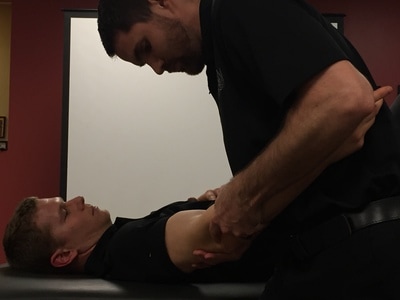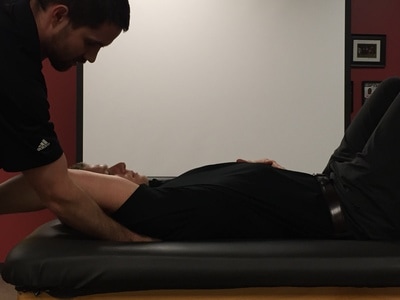- Home
- About Us
- TSPT Academy
- Online Courses
-
Resources
- Newsletter
- Business Minded Sports Physio Podcast
- Day in the Life of a Sports PT
- Residency Corner
-
Special Tests
>
-
Cervical Spine
>
- Alar Ligament Test
- Bakody's Sign
- Cervical Distraction Test
- Cervical Rotation Lateral Flexion Test
- Craniocervical Flexion Test (CCFT)
- Deep Neck Flexor Endurance Test
- Posterior-Anterior Segmental Mobility
- Segmental Mobility
- Sharp-Purser Test
- Spurling's Maneuver
- Transverse Ligament Test
- ULNT - Median
- ULNT - Radial
- ULNT - Ulnar
- Vertebral Artery Test
- Thoracic Spine >
-
Lumbar Spine/Sacroiliac Joint
>
- Active Sit-Up Test
- Alternate Gillet Test
- Crossed Straight Leg Raise Test
- Extensor Endurance Test
- FABER Test
- Fortin's Sign
- Gaenslen Test
- Gillet Test
- Gower's Sign
- Lumbar Quadrant Test
- POSH Test
- Posteroanterior Mobility
- Prone Knee Bend Test
- Prone Instability Test
- Resisted Abduction Test
- Sacral Clearing Test
- Seated Forward Flexion Test
- SIJ Compression/Distraction Test
- Slump Test
- Sphinx Test
- Spine Rotators & Multifidus Test
- Squish Test
- Standing Forward Flexion Test
- Straight Leg Raise Test
- Supine to Long Sit Test
-
Shoulder
>
- Active Compression Test
- Anterior Apprehension
- Biceps Load Test II
- Drop Arm Sign
- External Rotation Lag Sign
- Hawkins-Kennedy Impingement Sign
- Horizontal Adduction Test
- Internal Rotation Lag Sign
- Jobe Test
- Ludington's Test
- Neer Test
- Painful Arc Sign
- Pronated Load Test
- Resisted Supination External Rotation Test
- Speed's Test
- Posterior Apprehension
- Sulcus Sign
- Thoracic Outlet Tests >
- Yergason's Test
- Elbow >
- Wrist/Hand >
- Hip >
- Knee >
- Foot/Ankle >
-
Cervical Spine
>
- I want Financial Freedom
- I want Professional Growth
- I want Clinical Mastery
Cozen's Test
Purpose: To determine the presence of lateral epicondylalgia.
Test Position: Standing or sitting.
Performing the Test: Stabilize the patient’s forearm and instruct the patient to make a fist, pronate the forearm, radially deviate, and extend the wrist. Next the clinician palpates the lateral epicondyle with the stabilizing hand and applies a flexion force against the patient’s resistance. A positive test is reproduction of lateral elbow pain.
Diagnostic Accuracy: Unknown.
Importance of Test: According to Neumann, the common proximal attachment site of the wrist extensors is on or near the lateral epicondyle of the humerus and dorsal border of the ulna. The distal attachments of the extensor carpi radialis longus and brevis are the 2nd and 3rd metacarpals respectively. These muscles are responsible for wrist extension and radial deviation. The extensor carpi ulnaris attaches to the 5th metacarpal and is responsible for wrist extension and ulnar deviation. With tendinopathy, any stretch or contraction of the tissues can potentially reproduce pain. The starting position of the test (elbow flexion, wrist extension, radial deviation, and pronation) places the muscles in a shortened position. The combination of resisted contraction and palpation of the origin of the muscles reproduce the patient's symptoms.
Note: these tests should only be used by properly trained health care practitioners
Test Position: Standing or sitting.
Performing the Test: Stabilize the patient’s forearm and instruct the patient to make a fist, pronate the forearm, radially deviate, and extend the wrist. Next the clinician palpates the lateral epicondyle with the stabilizing hand and applies a flexion force against the patient’s resistance. A positive test is reproduction of lateral elbow pain.
Diagnostic Accuracy: Unknown.
Importance of Test: According to Neumann, the common proximal attachment site of the wrist extensors is on or near the lateral epicondyle of the humerus and dorsal border of the ulna. The distal attachments of the extensor carpi radialis longus and brevis are the 2nd and 3rd metacarpals respectively. These muscles are responsible for wrist extension and radial deviation. The extensor carpi ulnaris attaches to the 5th metacarpal and is responsible for wrist extension and ulnar deviation. With tendinopathy, any stretch or contraction of the tissues can potentially reproduce pain. The starting position of the test (elbow flexion, wrist extension, radial deviation, and pronation) places the muscles in a shortened position. The combination of resisted contraction and palpation of the origin of the muscles reproduce the patient's symptoms.
Note: these tests should only be used by properly trained health care practitioners
References:
Neumann, Donald. "Kinesiology of the Musculoskeletal System: Foundations for Rehabilitation." 2nd edition. St. Louis, MO: Mosby Elsevier, 2010. 232. Print.
Neumann, Donald. "Kinesiology of the Musculoskeletal System: Foundations for Rehabilitation." 2nd edition. St. Louis, MO: Mosby Elsevier, 2010. 232. Print.
Copyright © The Student Physical Therapist LLC 2023




